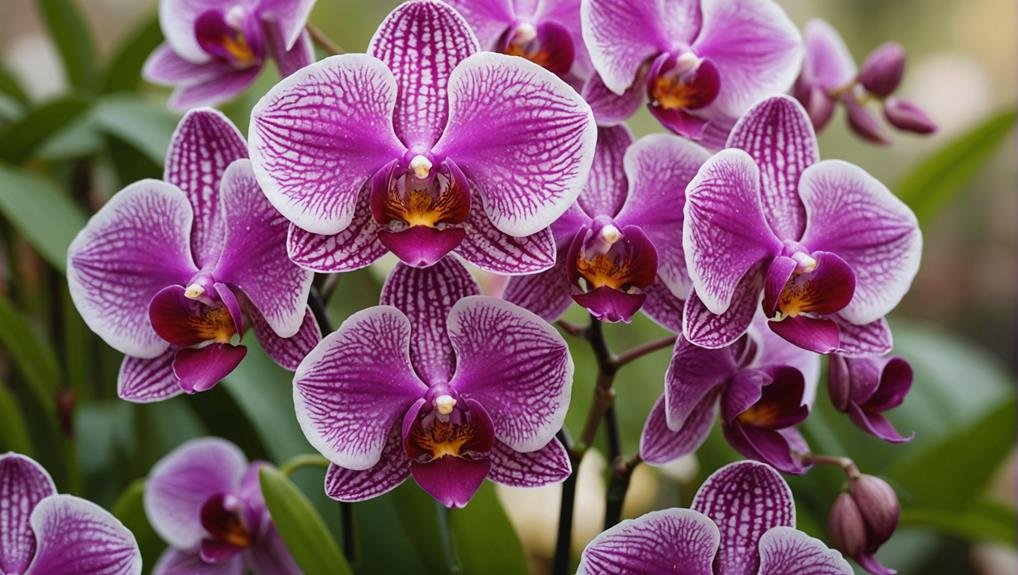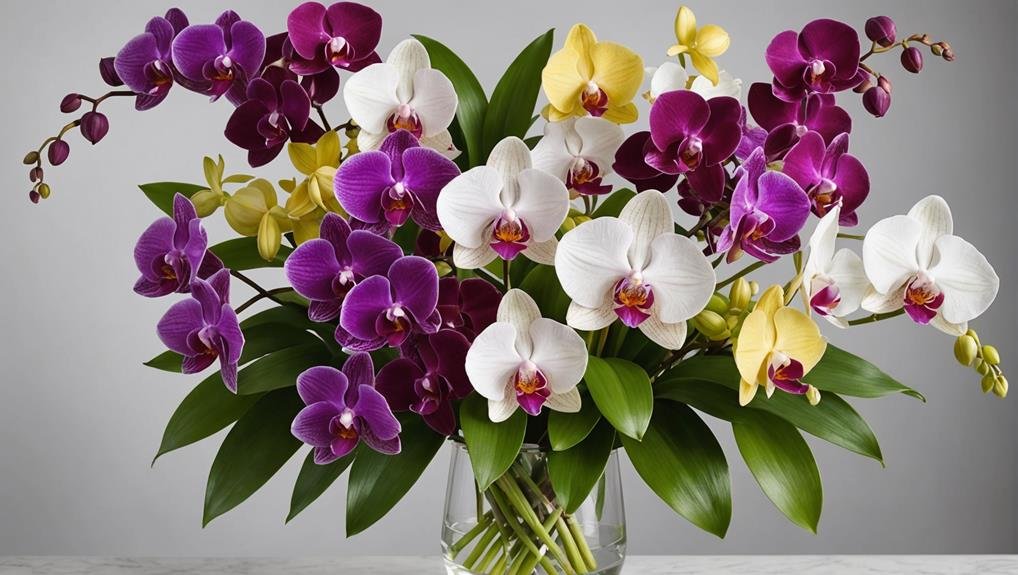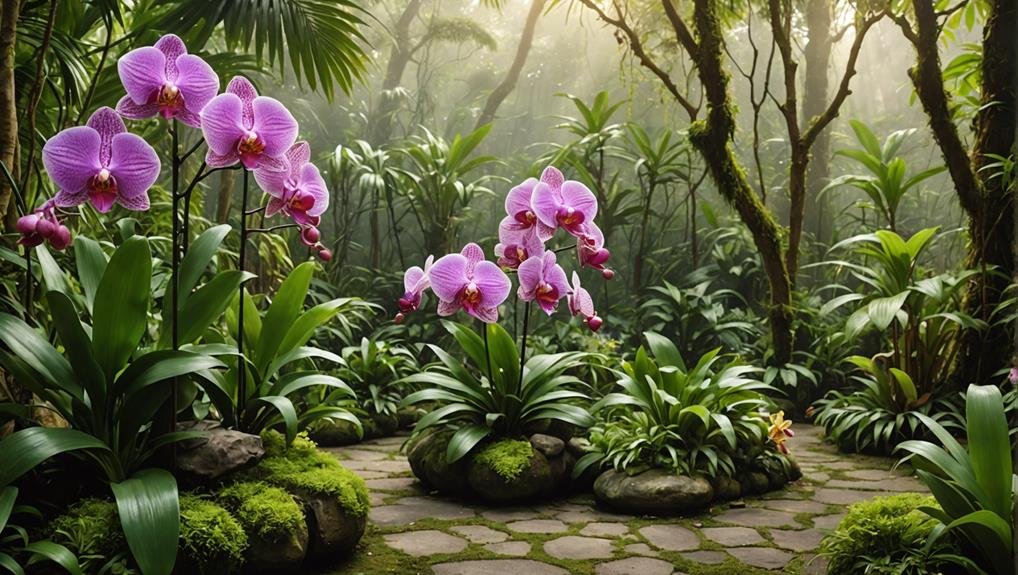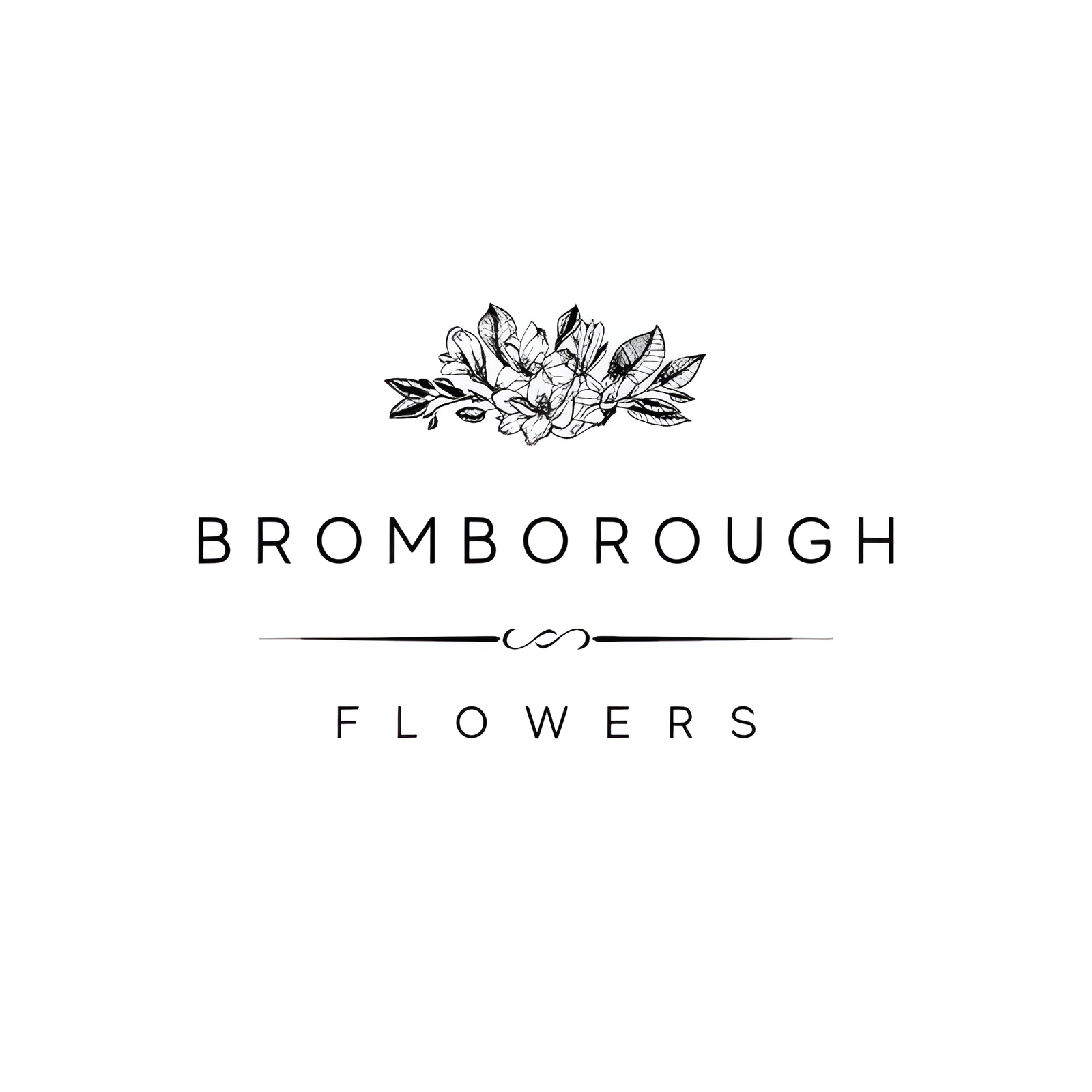In the world of bridal floristry, orchids stand out as a quintessential choice, embodying both sophistication and versatility. With their diverse array of shapes and hues, orchids like Phalaenopsis, Cattleya, and Cymbidium bring a unique charm to wedding aesthetics. Their cultural symbolism of luxury, fertility, and refinement further amplifies their appeal. However, the true allure of orchids lies not just in their beauty but in their adaptability to various wedding elements, from bouquets to centerpieces. To fully grasp the potential of incorporating orchids into your wedding, one must consider their distinctive features and ideal uses.
Flower Overview

When selecting flowers for a wedding, understanding the diverse varieties of orchids can help create a memorable and elegant floral arrangement. Among the most popular choices are Phalaenopsis orchids, Cymbidium orchids, and Cattleya orchids, each offering distinct features that can enhance the aesthetic appeal of any wedding setting.
Phalaenopsis orchids, often referred to as moth orchids, are favored for their wide, flat flowers and tall stems. Their graceful appearance makes them a versatile option for various wedding themes, from classic to contemporary. These orchids are particularly popular for bridal bouquets and centerpieces due to their elegant yet understated beauty.
Cymbidium orchids, on the other hand, grow in clusters and are characterized by their grassy leaves. This variety adds a unique texture to floral arrangements, making them ideal for more naturalistic or rustic wedding designs. Their clustered growth pattern allows for creative and dynamic bouquet compositions.
Cattleya orchids are renowned for their large, ruffled-edged flowers and strong fragrances. These orchids are perfect for creating dramatic bouquets and statement pieces. Their vibrant colors and bold structure make them a standout choice for couples looking to make a bold impression with their floral arrangements.
Physical Description
Orchids frequently exhibit a remarkable diversity in form, featuring a wide range of shapes, sizes, and colors that cater to various aesthetic preferences. Among the most popular varieties are Phalaenopsis orchids, Cattleya orchids, and Cymbidium orchids, each with distinct physical attributes.
Phalaenopsis orchids, often referred to as ‘moth orchids,’ are characterized by their broad, flat flowers that sit atop tall, slender stems. These orchids typically display a graceful, simplistic elegance, making them a favorite for wedding bouquets and arrangements. White orchids within this variety are particularly sought after for their pristine and timeless appearance.
Cattleya orchids, on the other hand, are renowned for their larger, more flamboyant blooms with ruffled edges. This variety often exudes a strong fragrance, adding an aromatic element to their visual appeal. The robust nature and bold presence of Cattleya orchids make them ideal for creating statement floral arrangements.
Cymbidium orchids, distinguishable by their clustered growth and grassy leaves, offer a different aesthetic. Their flowers tend to be smaller and more numerous, providing a lush, textured look. Together, these varieties highlight the extensive versatility and beauty inherent in orchids, making them a quintessential choice for wedding florals.
Available Colour Varieties

In addition to their diverse physical forms, orchids are celebrated for their wide array of enchanting color varieties, ranging from pristine whites to vibrant pinks, purples, and yellows. This diverse palette allows them to complement various wedding themes and floral arrangements seamlessly.
White Phalaenopsis orchids, for instance, are often chosen for their elegant, pure appearance, making them a sophisticated choice for bridal bouquets alongside Pink Roses and Calla Lily.
Hybrid orchids offer an even broader spectrum of colors and shapes, catering to the desires of brides and event planners seeking unique and striking floral elements. These hybrids can feature mesmerizing patterns and spots on their petals, adding an extra layer of visual interest to any arrangement.
For those looking to incorporate a touch of vibrant color, orchids in shades of pink and purple stand out as popular choices. Their rich hues can bring a lively and romantic ambiance to the setting.
Yellow orchids, though less common, add a bright, cheerful touch and pair beautifully with other flowers to create a dynamic and radiant bouquet. Each color variety brings its own charm and elegance, allowing for endless creativity in wedding flower design.
Latin Name and Taxonomy
As members of the Orchidaceae family, orchids boast an extraordinary diversity with over 25,000 species and 100,000 hybrids documented globally. The Latin name for orchids, Orchidaceae, is derived from the Greek word ‘orkhis,’ meaning testicle, a reference to the shape of their tubers. This vast family is one of the largest and most diverse among flowering plants, offering a wide array of shapes, colors, and sizes.
Taxonomically, orchids are fascinating due to their complex reproductive structures. These include specialized petals and columns uniquely adapted for pollination. The Orchidaceae family is divided into two primary subfamilies: Apostasioideae, which comprises the primitive orchids, and Orchidoideae, considered the advanced orchids. This classification underscores the evolutionary breadth within the family, from the more basal forms to the highly specialized.
The intricate taxonomy of orchids highlights their adaptability and evolutionary success. Their ability to hybridize further expands their diversity, making them a popular choice for wedding arrangements.
Understanding the taxonomy and Latin name of orchids not only enriches our appreciation for these elegant blooms but also underscores their botanical significance.
Geographical Origins

With their origins spanning tropical regions such as Asia, South America, and Australia, orchids exhibit remarkable adaptability to diverse climates and ecosystems. The geographical distribution of orchids is extensive, encompassing a range of specific climates from humid jungles to arid deserts. Different orchid varieties thrive in these distinct environments, showcasing their resilience and versatility.
In Asia, numerous orchid species flourish in the lush rainforests where humidity and warmth create ideal natural growing conditions. South America, particularly the Amazon Basin, is another hotspot for orchid diversity, with many varieties adapted to the rainforest’s complex ecosystem. Australia, too, boasts a rich array of orchids, with some species uniquely suited to its varied climates, from tropical regions to more temperate zones.
Understanding the geographical origins of orchids is pivotal for successful cultivation and floral arrangements. By replicating their natural growing conditions, horticulturists can ensure the health and vibrancy of these exquisite flowers. Some orchids are endemic to specific regions, meaning they are naturally found only in those areas, while others have been cultivated worldwide, showcasing their adaptability. This global distribution underscores the orchid’s extraordinary ability to flourish in a multitude of environments.
Season Availability
Understanding the geographical origins of orchids sets the stage for considering their seasonal presence, which is influenced by both natural climate conditions and cultivation practices. Orchids come from diverse regions, each with its unique climate, leading to varying periods of presence throughout the year.
For instance, some orchid varieties may be more abundant in the spring or summer, while others flourish in cooler months. Researching the specific seasonality of your preferred orchid variety is vital to guarantee its availability for your wedding. This knowledge not only ensures the highest quality blooms but can also help control costs. In-season orchids are generally more affordable and vibrant, as they do not require extensive out-of-season cultivation or importation.
Collaborating with a local florist can be invaluable in understanding the seasonal presence of orchids. Florists are well-versed in the blooming cycles of various orchid species and can provide expert advice on the best times to source specific varieties. Should your preferred orchid be out of season, they can also suggest suitable alternatives that align with your wedding theme and budget.
Flexibility and open communication with your florist can lead to stunning, cost-effective floral arrangements for your special day.
Growing Conditions

Successfully cultivating orchids requires a thorough understanding of their specific growing conditions. These exotic flowers demand a balance of light, temperature, humidity, and watering practices to thrive. To maintain optimal orchid care, it is essential to focus on the following elements:
- Light: Orchids thrive in indirect sunlight. Direct sunlight can scorch the leaves, while insufficient light can hinder blooming. Aim to place them in a location where they receive bright, filtered light for several hours daily.
- Temperature: Orchids prefer consistent temperatures between 60-80°F. Abrupt temperature changes can stress the plants, leading to poor growth and fewer blooms. Maintaining a stable environment is key to their health.
- Humidity: Proper humidity levels are crucial for orchid care. Orchids typically thrive in a humidity range of 50-70%. Using a humidity tray or a room humidifier can help maintain the necessary moisture levels, preventing dehydration and promoting robust growth.
- Watering: Watering orchids sparingly is vital to avoid root rot. The potting mix should be well-draining, allowing the roots to dry out between watering sessions. Overwatering can lead to waterlogged soil and unhealthy roots.
Incorporating these practices ensures that orchids remain healthy, vibrant, and ready to grace any wedding setting with their elegant presence.
Cultural Significance
Beyond their specific growing conditions, orchids hold a profound cultural significance across various civilizations. In ancient Greek culture, orchids were symbols of fertility and virility, making them an auspicious choice for wedding flowers. This historical association enhances the emotional depth of an orchid bouquet, bestowing upon it a legacy of prosperity and new beginnings.
In Chinese traditions, orchids are emblematic of refinement and friendship. The delicate beauty and symmetrical structure of these flowers make them ideal representations of high moral standards and harmonious relationships. This cultural significance aligns well with the themes of unity and companionship celebrated in weddings.
The Aztecs revered orchids for their symbolism of strength and power. Such attributes add a layer of resilience and fortitude to the orchid bouquet, making it a fitting metaphor for the enduring nature of marital bonds.
During the Victorian era, orchids were prized for their luxury and elegance. Their exotic appearance and rarity made them a status symbol, enhancing the splendor of any wedding event.
In Japanese culture, orchids are frequently depicted in art and literature, symbolizing beauty and grace. Their inclusion in wedding flowers thereby conveys a sense of aesthetic perfection and cultural richness.
Typical Use in Weddings

Orchids play a pivotal role in wedding floristry, often used in posies, centerpieces, corsages, and various decor elements to symbolize love, beauty, and luxury. Their diverse colors and shapes make them a versatile choice for any wedding theme, enhancing the elegance and grace of the event. Among the many types available, Dendrobium orchids are particularly favored for their delicate yet resilient nature.
- Posies: Orchids, especially Dendrobium orchids, are frequently chosen for bridal posies. Their long-lasting quality guarantees that the posy remains fresh throughout the day. The flowers’ intricate patterns and vibrant colors add a touch of sophistication.
- Centerpieces: Orchids create stunning centerpieces that captivate guests. When combined with other flowers or displayed in elegant vases, they can transform a simple table into a work of art, maintaining their allure from the ceremony to the reception.
- Corsages: For corsages, the durability of orchids makes them an ideal choice. Whether pinned to a dress or worn on the wrist, they retain their beauty and structure, symbolizing enduring love.
- Decor Elements: Orchids also play a significant role in overall wedding decor. They can be used in archways, aisle runners, and hanging arrangements, providing a luxurious and cohesive floral theme.
Alternative Flower Types
Exploring alternative flower types for wedding arrangements can provide a fresh and personalized touch to the event’s floral decor. While orchids are a popular choice, incorporating other blooms can enhance the diversity and uniqueness of the arrangements.
Roses, for example, are timeless and versatile, available in a wide spectrum of colors to match any wedding theme. Their classic elegance makes them a staple in bridal bouquets and centerpieces. Lilies offer a sophisticated and fragrant option, with varieties like calla lilies adding a sleek, modern touch to floral designs. Peonies, known for their lush, full blossoms, bring a romantic and luxurious feel, perfect for spring and early summer weddings.
For those seeking a more vibrant and seasonal approach, sunflowers, dahlias, hydrangeas, and ranunculus offer rich colors and textures that can transform any wedding setting. Succulents, protea, anemones, and wildflowers provide a unique and trendy aesthetic, appealing to couples looking for non-traditional options.
Additionally, incorporating elements like eucalyptus, baby’s breath, lavender, and ferns can add layers of texture and greenery, enhancing the overall visual appeal of the arrangements. Exotic blooms such as bird of paradise, hibiscus, and king protea introduce a striking, tropical flair, creating unforgettable floral displays.
